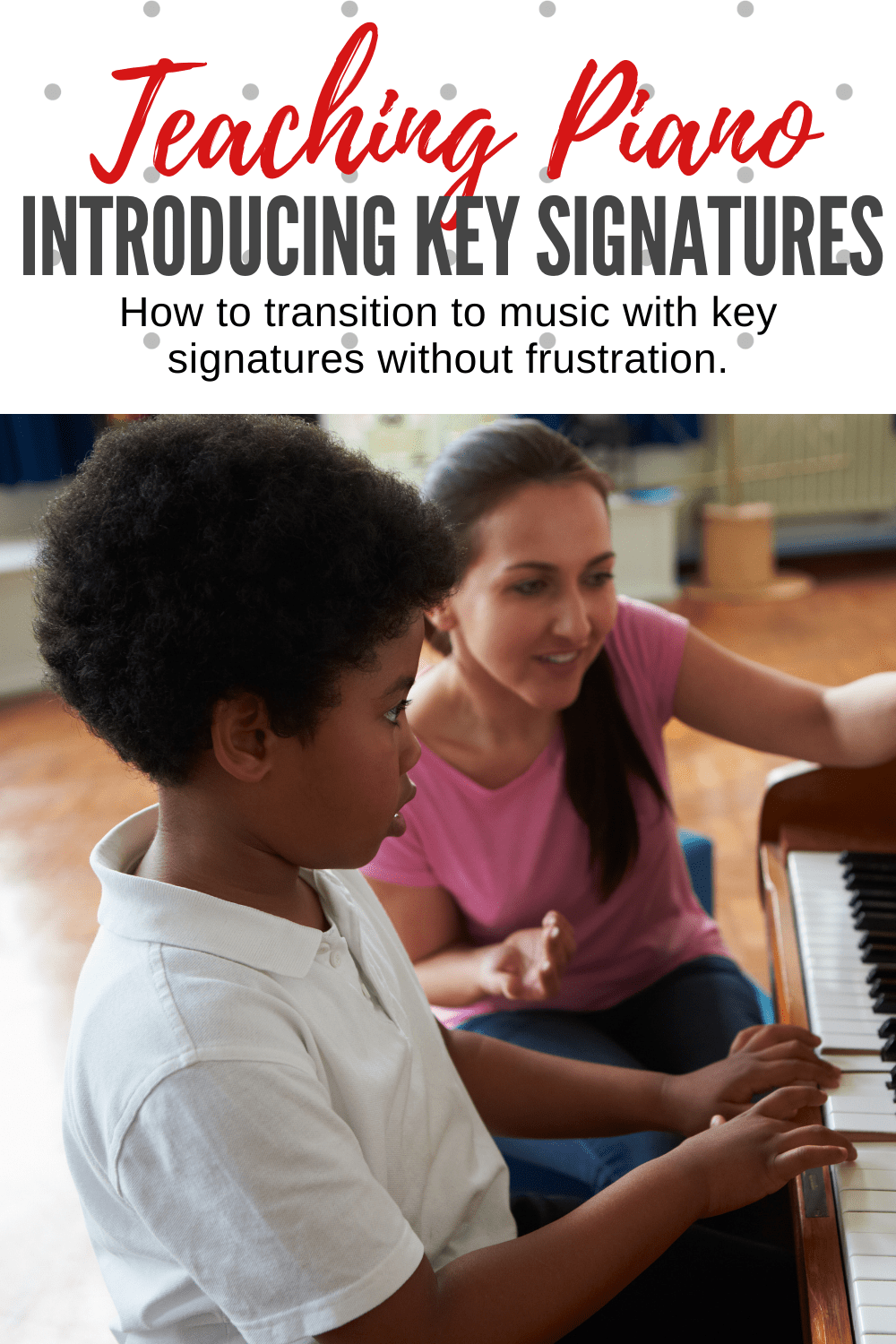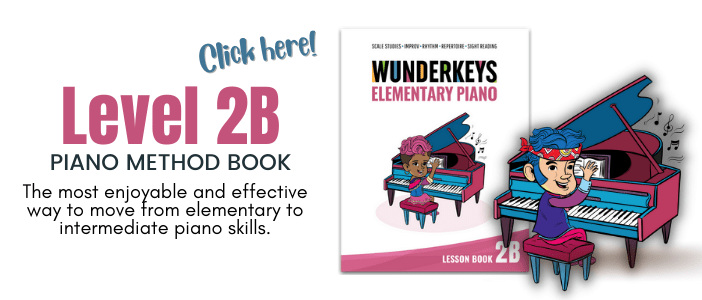Key signatures make a lot of sense to composers, teachers, and experienced pianists. But when introducing key signatures for the first time, young students view them as a thief who arrives one day and steals all of the helpful accidentals.
No wonder kids find them frustrating! One day the accidentals are in their music and the next, they’re gone! No warning, no transition, just… poof!
So today, we’re sharing a teaching tip that can help piano students who have been recently introduced to key signatures and are feeling a little frustrated.

Introducing Key Signatures With Highlighter Helpers
I love visual teaching tools, and few things are more visual on sheet music than highlighters. When introducing key signatures, using highlighters to locate sharps and flats in the music can make all the difference. They rescue many piano students who are just not ready for the sudden withdrawal of accidentals.
Follow the procedure below when using highlighters to reinforce key signatures (D major is used as an example):
- Assign a colored highlighter to each accidental in your student’s piano piece. For example, if a piece is in D Major, have a blue highlighter represent F# and a red highlighter represent C#.
- Next, highlight the sharps in the key of D major at the start of the piece.
- Instruct your student to then search for and highlight in blue, every F in her music. Then, have your student search for and highlight in red, every C in her music.
- Have your student play through the piece, using the colored notes as accidental reminders.
- Over time, gradually reduce the number of highlighted accidentals in your piano student’s music. For example, for a few weeks, have your student only highlight the first C and the first F in each measure of a piano piece. After a few weeks, have your student only highlight the first C and the first F in the piano piece.
- Assess how the highlighter strategy is working and eventually remove highlighter markings altogether.
The key to your student’s success is the gradual withdrawal of highlighted notes on a predictable schedule. Your student needs to know that the highlighter helpers will be removed. You want to be careful to avoid a reliance on highlighted notes, just as you want to be careful with a younger piano student who develops a reliance on note names being written above every note in a piano piece.
A Piano Method Book That Makes It Simple
The transition to key signatures is one of the most important teaching moments for your elementary piano students. But with the approach we take in WunderKeys Elementary Piano Level 2B, all the guesswork is removed! With a step-by-step introduction, your students won’t even blink when key signatures become a part of their music. Find out more here.


I have been highlighting sharps or flats for my beginning key signature readers, but i LOVE the idea of two colors!! Brilliant! Thank you!
Glad you found it helpful, Karen! 🙂
Another option would be the Avery see-through dots which are also removable. https://img.avery.com/f_auto,q_auto,c_scale,w_250/web/products/labels/72782-05796-p04p
Another way I’ve “highlighted” inside books is by using Post-It note flags. It’s great because they are reusable for the next piece but don’t permanently mark the paper (sheet music we’ll use regular highlighters!). Another option is eraseable colored pencils. They cost more, but I love having a coloring option that can also be erased when a visual is no longer needed. I often have students find “musical twins” (sections of music that are identical to each other) and circle the sections with the same color. In fact, my own 6 years old daughter will often grab some colored pencils when she looks at a new piece because hunting for the twins is fun. Little does she know she’s developing some great musical thinking skills! Lots of super colorful music in my studio!
Don’t forget to pair the piece with the scale too
Absolutely!
I like using the post it highlighter flags too because they are removable. They sell some at dollar tree that cost less than name brand with more color options. I use them for trouble spots and the students like seeing them cleaned off as they fix the elements they were missing like dynamics, rhythm or note troubles. They replace “the pencil” in some of my hand over the pencil activities when students use music from my lending library. http://heidispianonotes.blogspot.com/2010/04/hand-over-pencil-actively-engaging.html
I had a teen student who had a piece with multiple sharps and she just used a slash Mark (/) on the sharps she needed to remember. I had never thought of that before! And this would also make a nice transition from highlighters to occasional reminder! I even used that in one of my pieces this holiday season.
Ooh I like that! Do you mean across the note stem?
Erasable highlighters are great for this!
Those will be in my basket the next time I’m at Staples!
Oh, how great your post was today. I’ve used coloured key signatures for a long time and it works. There is so much to train the eyes to see everything, the colours actually help in training the eyes.
Hi Patricia – yes, I’ve found that it helps train eyes and also helps students to automatically find the right hand shapes on the piano to incorporate the accidentals. Good things all around! 🙂
They have highlighter tape that can be removed. it is the best thing going.
I have a student coming today with whom I will use this activity! I have some of the highlight tape I may use, depending upon how she did practicing over the holidays! Thanks!!! Always LOVE your suggestions and use them!
So glad to hear it, Aleta!